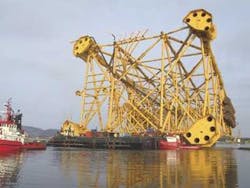Aker Kværner offering new model for jacket engineering
Interest is growing in the services offered by Aker Kværner Jacket Technology (AKJT), which was set up a year ago to support Aker Kværner’s specialized jacket fabrication yard in Norway, Aker Verdal, and to find new outlets for its jacket expertise in the global market.
In 2004, Aker Kværner’s jacket engineering expertise was gathered together in AKJT, which is headed by Managing Director Bjørn Rognlien. The company has a small staff, which is augmented as required by contract personnel, and can draw on the resources of other Aker Kværner companies. Its closest partner is Aker Kværner Engineering and Technology, the mainstay of the group’s topsides engineering expertise.
In recent years, Aker Verdal has entered the UK market, winning jacket contracts for Shell’s Goldeneye, BP’s Clair, and most recently EnCana’s Buzzard project. Outside the North Sea, however, there have been few fabrication opportunities, as most countries with established offshore sectors reserve jacket work for their own yards. However, there is scope for AKJT to add value to jacket projects in foreign countries.
This could be done through establishing long-term relationships with local contractors and fabricators, says Rognlien. AKJT could then contribute engineering solutions conducive to more effective fabrication methods, hopefully realizing improvements in future projects.
Mumbai nine
The company is already enacting its strategy, according to Jacket Manager Torstein Alm. In India, together with its local associate Kværner Powergas, it won a $4-million contract involving technical responsibility for the design of nine wellhead platforms for ONGC’s Mumbai High South development. The company had a team of four engineers working full-time on the project in India, supported from Oslo. The jackets, each weighing less than 2,000 tons, will support 700-ton topsides and will be installed in water depths of 69-85 m. Five of the platforms are due for delivery this year and the remainder in 2006.
In Iran, the company is supporting Aker Kværner Engineering and Technology in tendering to local yards to provide jacket engineering for several platforms.
Last year, an agreement was also signed with Mexican state engineering company Instituto Mexicano del Petróleo (IMP), which performs most of the conceptual design work for state oil company Pemex. Four IMP engineers spent a month in Oslo familiarizing themselves with the company’s working procedures. In concert with these engineers, AKJT then undertook a two-month study for a jacket to be installed in 250 m of water, the deepest installation yet in the Mexico sector.
In the Far East, the company has carried out a number of assignments for the local company Aker Kværner Asia Pacific in Singapore. The latest, a review and verification of a jacket project undertaken by the Singapore office, was performed last year.
Long-term collaboration between engineering and fabrication personnel can lead to a marked improvement in performance, Rognlien says. He cites an example involving Aker Verdal, which built Norsk Hydro’s Brage and Grane jackets, which were delivered respectively in 1993 and 2003. They are similar structures, with roughly the same weight - 18,300 tons for Brage against 17,500 for Grane. But construction of Grane took only half the man-hours required for Brage.
The collaboration between the Oslo-based engineering resources and the Verdal yard kicked off in 1991 with the Sleipner riser platform for Statoil, which was designed and built in just one year following the loss of the Sleipner A concrete gravity-base structure during submersion tests.
“That was how the template for working together was formed,” says Rognlien. “We had a real focus on getting a model that was simple to fabricate. It was a different attitude to working, very focused on the delivery schedule. We’ve since worked together on 20 jackets including current projects, using the same model.”
During this period, in which the two sides have got to know each other very well, the yard has benefited from getting designs suited to its production methods.
Together the partners offer a strong engineering, procurement, and construction (EPC) capability, and this is the key to gaining control over the whole value chain, Rognlien says. For the customer, the tangible benefit is that projects are completed in fewer work-hours and at a lower price than through a fabrication only strategy. Since the collaboration began, only two of the 21 jacket contracts won by Aker Verdal have been awarded with a pure fabrication scope.
When invited to tender for a fabrication contract, Aker Verdal has often also submitted an EPC bid and on several occasions has ended up persuading the customer that this was the better option. The most recent example is the Buzzard jackets for Nexen (the contract was awarded by EnCana, the previous operator), which were originally tendered as a fabrication contract.
“The key factors in this success can be attributed to exceptional product understanding - the ability to develop effective and safe concepts - and subsequent project execution,” says Rognlien.




